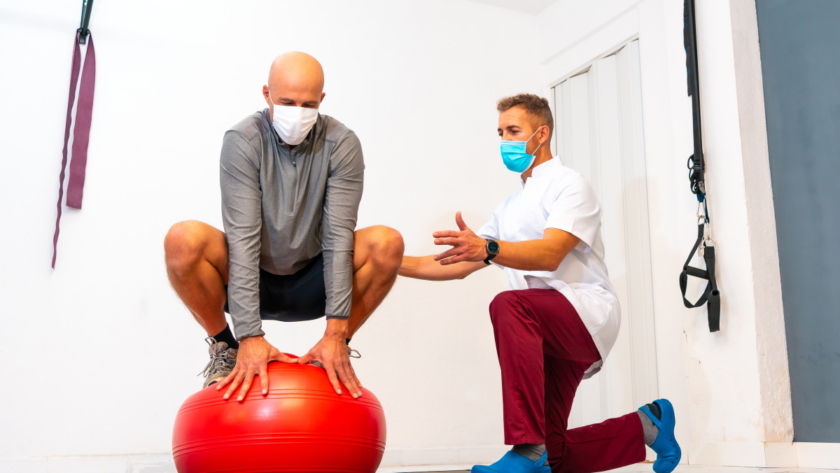Vestibular Rehabilitation Therapy
Feeling Dizzy? That’s your Vestibular System at work! Get Vestibular Rehabilitation Therapy from Any of the 5 clinics of Activa Clinics in GTA.
Although we all rely on it extensively, most people have never heard of the vestibular system..
The Vestibular system
In simple words, the vestibular system is a sensory system. It consists of the inner ear organ that detects motion and the parts of the brain that process this information. In addition, this system plays a role in motor activities such as balance, head and body stabilization during movement, and maintaining our posture. As a result, the vestibular system is crucial for proper movement and balance and to see clearly when the head is in motion.
Vestibular disorders
The vestibular system consists of parts of the inner ear and the brain components that interpret sensory information for balance and eye movement control. If these processing parts get damaged by disease or an injury, dizziness and balance problems might occur.
Vestibular disorders can also be caused by or made worse by genetic or environmental factors, or they might happen for no apparent reason.
Common Vestibular Disorders include:
- Vestibular Migraine
- Benign Paroxysmal Positional Vertigo (BPPV)
- Mal de Debarquement (MDD)
- Labyrinthitis or vestibular neuritis
- Cervicogenic Dizziness
- Recurrent Vestibulopathy
- Unilateral Vestibular Hypofunction (UVH)
- Head injury concussion or TBI
- Persistent Postural Perceptual Dizziness (PPPD)
- Post Concussion Syndrome (PCS)
- Age-related dizziness and imbalance
The best way to resolve issues with the vestibular system is through Vestibular Rehabilitation.
Vestibular Rehab Therapy
When the vestibular system is injured, the brain can compensate for the loss of inner ear function. It learns to depend on alternate signals from other systems in the body to cope with the disorienting signals coming from the vestibular system. This can be achieved through Vestibular rehabilitation therapy.
Vestibular rehabilitation therapy (VRT) is a research-based therapy that uses customized approaches to help the brain adjust for vestibular system abnormalities. It is an exercise-based program to reduce visual disturbance, vertigo and dizziness, imbalance, and falls.
There are many possible causes for dizziness, vertigo, and balance issues, and VRT is an effective treatment for many of them. It is a non-invasive and painless solution, as it usually involves a custom exercise program to retrain your body’s balance systems.
VRT can treat dizziness and balance issues caused by:
- Ageing
- Neck dysfunction
- Head injury
- Central nervous system issues
- Neuropathy (numbness in feet)
- Vestibular hypofunction or loss
- Benign Paroxysmal Positional Vertigo (BPPV)
A physiotherapist creates a treatment plan for vestibular rehabilitation therapy. It includes balance training exercises, gait training, head movement sequences, gaze stabilization exercises, functional training, and more.

Otoconia or Bio-crystals, which are a natural element of your balancing system, can sometimes create balance issues. For example, these crystals might throw off your balance if they land in the incorrect part of your inner ear. A physiotherapist can help you dislodge the crystals by guiding you through head movement sequences.
A complete vestibular rehabilitation examination is lengthy. You can expect the following at your visit to the physiotherapist:
- A discussion of the history and nature of your symptoms.
- Checking for more severe reasons of vertigo or unsteadiness
- Balance assessment (both stationary and moving)
- Checking for sensitivity to motion or changes in position
- Infrared video analysis aids in the evaluation of eye movements
- Checking for other issues that might be causing problems, such as neck pain or high blood pressure.
Following the evaluation, the healthcare practitioner may recommend several therapies. Eye exercise, sensitivity training, balance challenges, and techniques for dealing with cognitive and psychological effects are a few examples.
Canalith repositioning techniques are most effective in treating Benign Paroxysmal Positional Vertigo (BPPV) (the most frequent cause of vertigo).
Apart from patients suffering from vestibular problems, vestibular rehab can also help patients with orthopedic, sensory, or other brain-related diseases that impair balance.
How long does treatment take?
Some balance issues can be addressed in a single session or only a few days after beginning therapy, while others can take longer. Keep in mind, however, that the longer you wait to seek therapy, the more your brain adapts to the unfavourable changes in your balance. This makes retraining your body much more difficult.
How to get started
Numerous studies have proved VRT to effectively treat symptoms, including unilateral vestibular hypofunction, chronic dizziness, concussion, vestibular migraine, and other vestibular disorders.
With over 20 years of service in helping patients become pain-free, Activa Clinics is dedicated to providing excellence in vestibular rehabilitation. Visit our services page for more information, if you or someone you love is in need of vestibular rehab therapy, and find an Activa Clinics location in GTA near you!